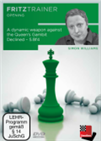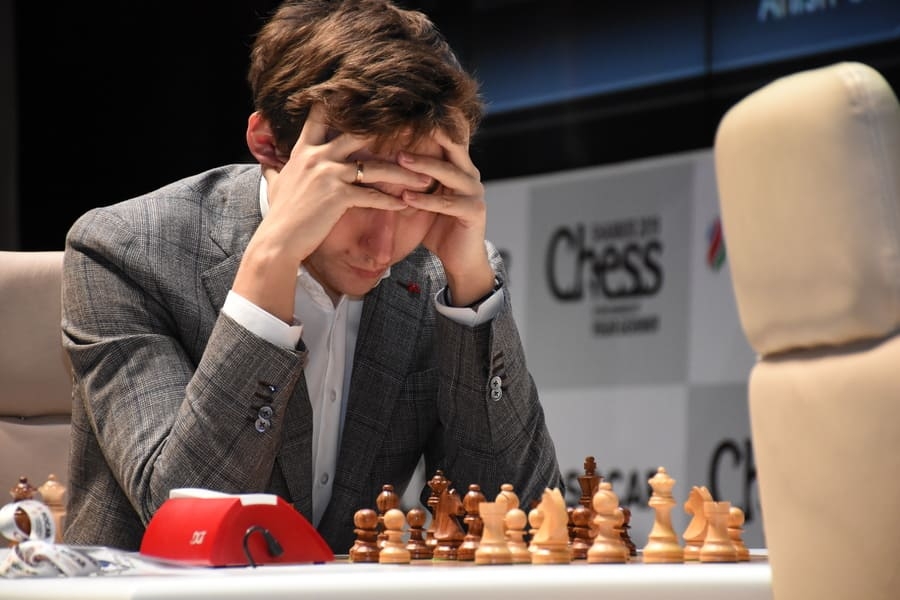No drawing streak this year
Are draws going to kill classical chess? This question is almost a hundred years old…and we are still waiting for the answer. After a first round that featured fighting chess that nonetheless led to five draws, the first three decisive games were seen already the next day. Both 2800+ participants won with White, while a topsy-turvy game eventually favoured Sergey Karjakin.
The first game to finish — like so many times in the past — was the one that faced compatriots Shakhriyar Mamedyarov and Teimour Radjabov. None of the players took more than six minutes in any individual move before signing the draw in a completely symmetrical position. No surprises here...

The ever-solid Teimour Radjabov | Photo: Official site
The most anticipated match-up of the day, however, made us quickly forget the ‘Azeri draw’, as Magnus Carlsen defeated his former World Championship challenger Vishy Anand with the white pieces. This was Carlsen's 48th straight game without a loss and his second straight win with White against Vishy — Anand also lost at this year's Tata Steel Masters.
The players followed the line played in the second game of the 2018 World Championship match, until Magnus deviated on move 12. By move 28, they had reached a materially balanced endgame in which White had a slight pull. That is when Anand started faltering, though — the 'Tiger of Madras' was upset with his play in the post-game press conference, so much so that he asked for permission to leave the interview after showing some lines.
Norwegian GM Aryan Tari sent us meticulous analysis of the game:
 This DVD concentrates on the increasingly popular 5.Bf4 variation of the Queen's Gambit Declined and gives White a dynamic and aggressive weapon against Black's set-up.
This DVD concentrates on the increasingly popular 5.Bf4 variation of the Queen's Gambit Declined and gives White a dynamic and aggressive weapon against Black's set-up.
Anand is having trouble facing the World Champion lately | Photo: Official site
The second game to finish saw Sergey Karjakin defeat Anish Giri from the black side of an Italian Opening. The Dutchman blitzed out his first thirteen moves, before spending over 23 minutes on move 14. Karjakin started taking his time a little earlier, aware of the fact that there were many hidden dangers in the position. Sergey, however, did not find the best setup for his pieces, and gave his opponent a golden opportunity in the early middlegame:
Feel free to move the pieces on the diagram above
Anish spent ten minutes before going for 20.♘h4 after having ruled out 20.♗xh6!, which was the right continuation. After 20...gxh6 White is able to bring all his pieces to the attack — e.g. 21.♘h4 ♚h8 22.♕g3 ♝xb5 23.axb5 ♞f4 24.♕f3 ♞bd5 25.♖e4.
But that is not what Anish chose, and perhaps that is what haunted him afterwards, as he lost control of the position when Karjakin tested him in complex continuations. The crucial mistake arrived in move 29:
 The Italian Game is considered a sound but quiet opening without early trades, giving rise to rich positions where plans are more important than forced variations. So shows black's plans on this DVD.
The Italian Game is considered a sound but quiet opening without early trades, giving rise to rich positions where plans are more important than forced variations. So shows black's plans on this DVD.
29.♗a2? was a straightforward miscalculation by Giri, who probably thought he had a winning attack via the open g-file. The game followed 29...♝xa2 30.♖xg6+ ♛xg6 31.♕xg6+ ♜g7:
White needs to give back his queen, as Black would give mate with ♖g2-♖d1 otherwise. But after 32.♕xg7+ ♚xg7 33.♖xa2 ♜d1 34.♖a1 ♚f7 White's queenside pieces are paralysed and Black will capture the f-pawn soon, giving way for his own far advanced passer. Giri resigned.

Full concentration is needed to navigate such a wild position | Photo: Official site
Alexander Grischuk played the Modern Benoni with Black against Ding Liren, a nice way to honour Gashimov's memory in Azerbaijan — Vugar strongly advocated this defence. Ding deviated from a line previously played by Levon Aronian on move 11 and went on to gain a pawn in the middlegame:
After 20.♗xh5, Black cannot capture the piece with 20...gxh5, as White would steamroll with his pawns on the kingside. Grischuk, therefore, played 20...c4 instead.
A strategic struggle ensued, and Ding correctly gave up an exchange shortly afterwards:
 The topic of this 60 minute video clip is the major idea of the 8.h3 0-0 9.Bd3 line. It has not won much love among defenders of the Benoni - White players are coming dangerously close to realising the dream of squeezing the opponent.
The topic of this 60 minute video clip is the major idea of the 8.h3 0-0 9.Bd3 line. It has not won much love among defenders of the Benoni - White players are coming dangerously close to realising the dream of squeezing the opponent.
23.♖xb3! wiped out Black's most active piece, and the game continued 23…cxb3 24.♛xb3. White had two pawns for the exchange, and a very nice flexible centre to boot.
The sharp battle continued and at some point the computer considered the position to be completely drawn, but from a human point of view it seemed impossible to fathom all the possibilities. In the end, White's passed pawns on the kingside decided the game in his favour:
Understandably, Grischuk decided to eliminate the active light-squared bishop with 47...♜f3+ 48.♔g2 ♛e2+ 49.♔h3 ♜xf5 50.♕xf5 ♛xd2 and Black was temporarily a piece up:
But White has the safer king and a very well-placed queen. Things only went for bad to worse for Grischuk, who had to give up his knight on move 63 and eventually resigned after 77 moves and over six hours of play.

It's never easy when you face the number three in the world | Photo: Official site
Fifty-five moves lasted the draw between Veselin Topalov and David Navara. The Bulgarian was quickly on top in the opening, as Navara confessed that he was out of book for a second day in a row as early as move 6. Topalov put pressure on Black's position but faced a stubborn Navara in defence. When an endgame was reached, Veselin decided to simplify the position, when keeping the rooks on the board might have given him better chances:
 The Caro Kann is a very tricky opening. Black’s play is based on controlling and fighting for key light squares. It is a line which was very fashionable in late 90s and early 2000s due to the successes of greats like Karpov, Anand, Dreev etc. Recently due to strong engines lot of key developments have been made and some new lines have been introduced, while others have been refuted altogether. I have analyzed the new trends carefully and found some new ideas for Black.
The Caro Kann is a very tricky opening. Black’s play is based on controlling and fighting for key light squares. It is a line which was very fashionable in late 90s and early 2000s due to the successes of greats like Karpov, Anand, Dreev etc. Recently due to strong engines lot of key developments have been made and some new lines have been introduced, while others have been refuted altogether. I have analyzed the new trends carefully and found some new ideas for Black.
The game continued 29.♖e8+ ♜f8 30.♖xf8+ ♚xf8 and White is still for choice in the materially balanced knight endgame. However, 29.♘d6 would have left more chances for both players to err. The former FIDE World Champion apparently feared Black's passed d-pawn in that situation…
The story from round one repeated itself — Topalov could not make good use of a superior position and Navara escaped with a draw from an inferior spot.

Fans were waiting for Veselin outside the playing hall | Photo: Official site
Standings after Round 2
| Rk. |
Name |
Rtg |
FED |
Pts |
| 1 |
Sergey Karjakin |
2753 |
RUS |
1 ½ |
| 2 |
Magnus Carlsen |
2845 |
NOR |
1 ½ |
| 3 |
Ding Liren |
2812 |
CHN |
1 ½ |
| 4 |
Teimour Radjabov |
2756 |
AZE |
1 |
| 5 |
David Navara |
2739 |
CZE |
1 |
| 6 |
Shak Mamedyarov |
2790 |
AZE |
1 |
| 7 |
Veselin Topalov |
2740 |
BUL |
1 |
| 8 |
Anish Giri |
2797 |
NED |
½ |
| 9 |
Alex Grischuk |
2771 |
RUS |
½ |
| 10 |
Vishy Anand |
2779 |
IND |
½ |
All games
Links




























